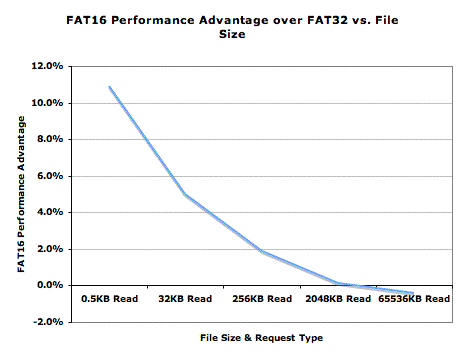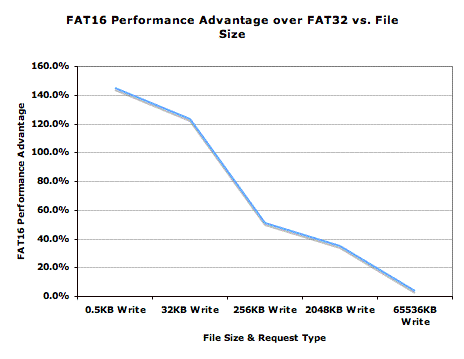USB Flash Drive Roundup - 10/2005
by Anand Lal Shimpi on October 4, 2005 11:28 AM EST- Posted in
- Memory
Impact of File System on USB Flash Drives
Although these days, most Windows XP hard drives are formatted as NTFS by default, there was a time when you had to choose what file system you wanted to use for your Windows PC: FAT16, FAT32 or NTFS. The move to very large hard drives pretty much killed off FAT16, but given that the largest USB flash drives weigh in at 4GB, and the majority are 2GB and smaller, the FAT16 file system has been given a new lease on life.
If you have a USB flash drive larger than 2GB, FAT16 is not an option, but given that most of the drives that we're looking at here today are only 512MB in size, FAT16 was just as viable as the other options in Windows.
Every single drive that we tested came pre-formatted with a FAT16 partition, and to understand why, you needn't look any further than a quick performance comparison between FAT16 and FAT32 on USB flash drives.
The graph below plots the average read performance advantage of FAT16 over FAT32 in KB/s as a function of file size for 19 USB flash drives; obviously, higher numbers are better:
The performance benefits are even greater when we look at write performance:
Note that not all drives exhibit such a preference for FAT16 over FAT32. The following table gives you a better idea of what drives benefit and which ones don't:
As you can see, those averages that we reported earlier are really dominated by a handful of drives that benefit tremendously from FAT16, such as the SanDisk Cruzer Titanium, Lexar JumpDrive Lightning and Crucial Gizmo!. Other drives actually drop in write performance such as the Kingston DataTraveler II+ migo.
Given that the average performance impact of FAT16 for these drives still ends up being positive, we chose to test all of them in FAT16. Although, keep in mind that some of these drives may exhibit better performance when formatted with FAT32.
Although these days, most Windows XP hard drives are formatted as NTFS by default, there was a time when you had to choose what file system you wanted to use for your Windows PC: FAT16, FAT32 or NTFS. The move to very large hard drives pretty much killed off FAT16, but given that the largest USB flash drives weigh in at 4GB, and the majority are 2GB and smaller, the FAT16 file system has been given a new lease on life.
If you have a USB flash drive larger than 2GB, FAT16 is not an option, but given that most of the drives that we're looking at here today are only 512MB in size, FAT16 was just as viable as the other options in Windows.
Every single drive that we tested came pre-formatted with a FAT16 partition, and to understand why, you needn't look any further than a quick performance comparison between FAT16 and FAT32 on USB flash drives.
The graph below plots the average read performance advantage of FAT16 over FAT32 in KB/s as a function of file size for 19 USB flash drives; obviously, higher numbers are better:

The performance benefits are even greater when we look at write performance:

Note that not all drives exhibit such a preference for FAT16 over FAT32. The following table gives you a better idea of what drives benefit and which ones don't:
| FAT16 Performance Impact | AVG Read Increase | AVG Write Increase |
| Corsair Flash Voyager | 4.5% | 10.4% |
| Crucial Gizmo! | 1.8% | 146.5% |
| Kingston DataTraveler | -0.5% | -3.8% |
| Kingston DataTraveler Elite | 2.2% | 6.5% |
| Kingston DataTraveler II | 2.0% | 0.2% |
| Kingston DataTraveler II Plus migo | 6.2% | -38.8% |
| Lexar JumpDrive Lightning | 7.8% | 605.5% |
| Memina Rocket | 9.6% | 7.4% |
| OCZ Rally | 10.6% | 31.2% |
| PQI I-Stick 2.0 | 0.1% | 16.4% |
| PQI I-Stick 2.0 Plus | 1.7% | 12.2% |
| PQI I-Stick Pro170 | 4.7% | 16.0% |
| SanDisk Cruzer Micro | 2.0% | -9.1% |
| SanDisk Cruzer Mini | 4.1% | -5.1% |
| SanDisk Cruzer Titanium | 2.2% | 576.0% |
| SanDisk Ultra II Plus USB | 4.1% | -18.9% |
| Shikatronics | -0.3% | 14.1% |
| Transcend JetFlash | 3.8% | -20.1% |
| Transcend JetFlash 110 | -0.4% | 8.6% |
As you can see, those averages that we reported earlier are really dominated by a handful of drives that benefit tremendously from FAT16, such as the SanDisk Cruzer Titanium, Lexar JumpDrive Lightning and Crucial Gizmo!. Other drives actually drop in write performance such as the Kingston DataTraveler II+ migo.
Given that the average performance impact of FAT16 for these drives still ends up being positive, we chose to test all of them in FAT16. Although, keep in mind that some of these drives may exhibit better performance when formatted with FAT32.










39 Comments
View All Comments
BJL - Monday, October 16, 2006 - link
Do the read and write speeds change for the 1gb and above models? Would I get the same performance, or should I stick with the 512mb?NeoZGeo - Monday, October 17, 2005 - link
what kinf of benchmark are you guys using? How come some of those drive write speed is sooooo low!? Like Trenscent, OCZ Rally, i've seen some reviews out there which says other wise.NeoZGeo - Monday, October 17, 2005 - link
here's the review by tom'sif you look at the trenscend jet flash, it actually has the highest write speed average out at 23.3 mb/s vs anandtech's 8.7 mb/s !? what the hell?
NeoZGeo - Monday, October 17, 2005 - link
haha oops, forgot about the link :Dhttp://www.tomshardware.com/storage/20050520/usb_f...">linky
quanta - Wednesday, December 7, 2005 - link
It looked like Tom's test is testing the write speed between USB host and flash drive's controller's memory buffer, instead of actual write speed, which can only be verify by doing a read after writing is completed. There are also reports that http://www.auphanonline.com/articles/view.php?arti...">cluster size may affect the write access behaviour. BTW, Tom's http://www.tomshardware.com/2005/08/10/two_fast_an...">later review has simultaneous reads and writes benchmark, which slows Memina Rocket to a halt.quanta - Wednesday, December 7, 2005 - link
In addition, even when using buffered write in SiSoft Sandra, it is extremely unlikely that Transcend Jetflash 110 can write anywhere near 23.3MB/s. http://www.oc.com.tw/article/0510/readparticle.asp...">This benchmark shows that when doing random write with Kingston DataTraveler ELITE, write speed dropped more than a half compared to sequential write.gaintstar - Wednesday, November 15, 2017 - link
More updating news about custom metal usb drives factory wholesale,advertising companies gifts, Flason Custom mini usb flash drives,Personalized plastic USB flash drives, custom twister usb flash drives, corporate brand building company gifts items,customized PU body memory sticks,promotional mobile phone usb 3.0 flash drives memory sticks,imprinted promotional products giveaways,custom plastic usb 2.0 drives,custom body usb storage flash drives suppliers....welcome to visit our website: www.flason.com, or send us your enquiry by email: sales@flason.comTrueWisdom - Wednesday, October 12, 2005 - link
I'm the in-house support for a university building and I've had absolutely horrible luck with Lexar drives. Lexar often fails to detect entirely on somewhat older machines (the Latitude C840, for example) and has also displayed a relatively high failure rate for me. I don't have any positive or negative impressions of Kingston drives, so I can't say anything there, but I will say that I've had by far the best luck with Sandisk drives. I've never had one fail on me, and I've seen them go through wash cycles, get run over by a car, and get left out in the rain. Compatibility has been universal as well. They may not be the fastest drives but they really are the only ones I've ever trusted.gaintstar - Wednesday, November 15, 2017 - link
More updating news about custom <a href="http://www.flason.com/Metal-USB-Flash-Drive.html&q... target="_blank">metal usb drives</a> factory wholesale,advertising companies gifts, Flason <a href="http://www.flason.com/Custom-PVC-USB-Drives.html&q... target="_blank">Custom mini usb flash drives</a>,Personalized <a href="http://www.flason.com/Plastic-USB-Flash-Drive.html... target="_blank"><a href=http://www.flason.com/Plastic-USB-Flash-Drive.html target='_blank'>plastic USB flash drive</a>s</a>, custom twister usb flash drives, <a href="http://www.flason.com/Branded-USB-Flash-Drive.html... target="_blank">corporate brand building</a> company gifts items,customized PU body memory sticks,promotional <a href="http://www.flason.com/Mobile-Phone-USB-Drive.html&... target="_blank">mobile phone usb 3.0 flash drives</a> memory sticks,imprinted promotional products giveaways,custom plastic usb 2.0 drives,custom body usb storage flash drives suppliers....welcome to visit our websitependrivethis - Friday, October 7, 2005 - link
i work for a flash memory controller maker and in all honesty the most meaningful performance test is random write. and no one really advertise that since sequential read speeds seem much more appealing and marketable. i can get a dual-channel & interleaving enabled usb 2.0 pen drive with micron or samsung nand-type flash to go up to 34mB/s in sequential read, but the engineer who designed this still tells me that he'd rather use and-type flash from renesas (formerly hitachi) since and flash has a better random write than nand flash.and knowing what i know, if you use your pen drive very often, and i suspect some of you may be in that boat, i'd check out some of the burn-in testing results especially since companies are not entirely using only samsung nand flash. certain new flash whether nand-type or ag-and-type and even some high-density samsung flash seem to be displaying a need for extra care in ecc. data-verify errors are fatal, especially if it's the only copy you got...
anand, perhaps a little visit to some of the design houses for these controllers the next time when you're in taiwan is in order. computex is only 9 months away.